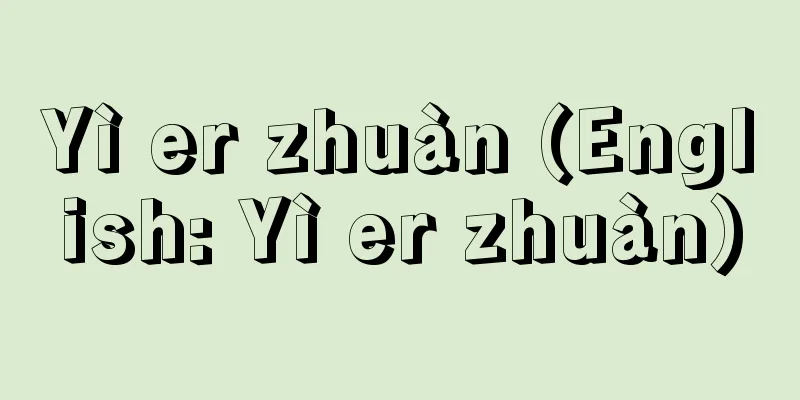Sanjo - Sanjo

|
A representative instrumental solo music of the Korean Peninsula. It developed under the influence of Sinaui, an instrumental ensemble that flourished mainly in Jeollanam-do in the southern part of the peninsula, and Pansori, a spoken language music. It is a variation style of music with a solo instrument and rhythmic accompaniment by a staff drum, and today Gayageum Sanjo, played on the Gayageum, is the most common. It is said to have been created by Kim Changjo around 1890, and has the widest range and a wide variety of keys. Other styles that are played include Hyeongeum Sanjo, Daesin Sanjo, and more recently Piri Sanjo and Gaso Sanjo. Each style has its own school, and is named after a person, and is called ○○-style Sanjo. Basically, it consists of three movements: Jinyanjo (slow), Chunmori (moderate), and Chajinmori (fast), with Chunmori followed by Chunjunmori, and Chajinmori followed by Himori and Danmori. Each movement uses a rhythmic pattern called Changdan, which indicates the length of the movement, and is performed without pause, from the slow Jinyanjo to the fast Danmori. In the slow and moderate movements, microtones produced by vibrato are played effectively, while in the fast movement, complex rhythms such as syncopation and hemiolas with changing beats are used. [Harumi Haratani] Source: Shogakukan Encyclopedia Nipponica About Encyclopedia Nipponica Information | Legend |
|
朝鮮半島の代表的な器楽独奏音楽。半島南部の全羅南道(ぜんらなんどう/チョルラナムド)を中心に栄えた器楽合奏の巫楽(シナウイ)と語物のパンソリの影響を受けて発達した。ソロ楽器と杖鼓(じょうこ)によるリズム伴奏との変奏形式の曲で、今日では伽倻琴(かやきん)による伽倻琴散調がもっとも一般的である。これは1890年ころ金昌祚(キムチャンジョ)によってつくられたといわれ、もっとも広い音域と多彩な調をそろえている。ほかに玄琴(げんきん)散調、大笒(たいしん)散調、最近では觱篥(ピリ)散調、牙箏(がそう)散調なども演奏される。それぞれに流派があり、人名をつけて○○流散調とよばれる。 基本的には、チンヤンジョ(緩)、チュンモリ(中庸)、チャジンモリ(急)の3楽章からなり、さらにチュンモリのあとにチュンジュンモリ、チャジンモリのあとにヒモリ、タンモリなどが加わる。各楽章は楽章名の示す長短(チャンダン)とよぶリズム型を用い、テンポの遅いチンヤンジョから速いタンモリまで、休まずに演奏される。緩、中庸楽章ではビブラートから出る微分音が効果的に奏され、急楽章ではシンコペーションや拍子が途中で変化するヘミオラなどの複雑なリズムが駆使される。 [原谷治美] 出典 小学館 日本大百科全書(ニッポニカ)日本大百科全書(ニッポニカ)について 情報 | 凡例 |
>>: Mountain Uprising - Sanchu Ikki
Recommend
Triterpene
… The hydrocarbon C 10 H 16 with n = 2 is called ...
dry dock
… [Dock type] Docks are classified into repair do...
Song Joruri - Uta Joruri
...Miyakoji Sonohachi, a disciple of Bungonojo, p...
Faith - Kyoushin
Year of death: 866 Year of birth: Unknown A nembut...
Robert, Hubert
Born: May 22, 1733, Paris [Died] April 15, 1808. P...
Nagarjunakonda - Nagarjunakonda (English spelling)
The ruins were located on the right bank of the Kr...
Odra [river] - Odora
→Oder [River] Source : Heibonsha Encyclopedia Abou...
Araeosoma
...They are found south of Sagami Bay at depths o...
Lucia
Another Japanese title for the opera "Lucia d...
Ujimune - Uji no Sou
...the head of a clan in ancient Japan. Also call...
Hidemi Ozaki
A communist and commentator on China issues. Born...
Entropy Elasticity - Entropy Dynamics
According to statistical mechanics, entropy in an...
serunai
…It is a wooden wind instrument that produces sou...
Premolar - Premolar
…Humans have eight deciduous teeth, two on each s...
Vinyl greenhouse - Vinyl House
For horticultural use, a roof-shaped or semicircu...









